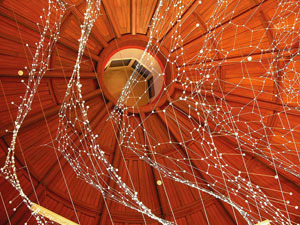Published: Verve Magazine, Nerve, June 2008
Inspired by ‘life’, 30-year-old installation artist Ranjani Shettar has created a buzz among the art circles, particularly in the US. She draws inspiration from deep-rooted Indian culture and traditions and finds a spiritual cognizance with the wispy installations that she has unwittingly made her signature style, incorporating simple materials like coconut fibres, resin, terracotta, wax, twine and metal in her work. Sitanshi Talati-Parikh talks to the artist from Bangalore who refuses to keep track of the marketability and rates of her works
Entitled Sun-sneezers blow light bubbles, Ranjani Shettar’s first solo show in a US museum is currently on at the Institute of Contemporary Art, Boston, Massachusetts, where suspended sculpture made with steel, tamarind powder and muslin is fashioned into organic shapes reminiscent of soap bubbles, containers of light or multiplying cells, creating a dreamy ambience. The artist, also concurrently showcasing at the prestigious 55th Carnegie International, Pennsylvania, isn’t sure of who has influenced her works through time. “The answer keeps changing every time someone asks me that question!” she remarks. Currently, she holds weight by William Kentridge, Martin Puryear, Eve Hesse and Tim Hawkinson.
Shettar prefers to use simple materials like thread and wax to car bodies and silicone rubber. “Ranjani Shettar’s use of materials both organic and man-made suggests the complex cultural associations of India and the collision of tradition and modernity,” opines Jill Medvedow, Director of the Institute of Contemporary Art.
She was very clear about her choice of installations over paintings. “My visualisation is in three dimensions and so it is much more natural for me to sculpt than paint.” She finds it more comfortable to work in space rather than on a flat surface, where she enjoys the act of involving herself physically and completely in the making of the work.
Originally trained as a sculptor, she started off in a classical way, with figurative sculptures in clay, wood, plaster and stone, where she learned to use the materials and her hands. It was a slow and gradual transition from the figurative to the abstraction. “Somewhere along the way,” she realised, “I needed to expand my choice of materials to be able to express myself better and that’s when I started using materials from my own surroundings.”
Shettar’s works straddle urban and organic forces. This is not surprising as she believes that, “each one of us is a reflection of our own surroundings, upbringing and our own mind. I have grown up being close to nature in a rural set up with my essentially urban family.”

